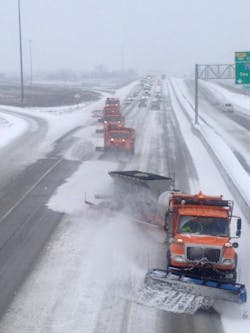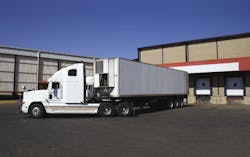With nearly three decades of state-level transportation experience under his belt, Trombino (at right) is now poised confront bigger, national-level issues during his one-year term; the biggest, of course, being passage of a comprehensive long-term highway bill.
Of more interest to trucking, though, is Trombino’s focus on the importance of improving U.S. freight efficiency as he strongly believes that gives the U.S. its “competitive edge” in the global economy.
“From my perspective, freight is a major issue,” he told me by phone. “We must find a way to make freight movements more efficient.”
Trombino added that includes enabling greater efficiency of each mode within the supply chain – trucks, rail, water, even shipper facilities – because the more efficient freight is, the more competitive the U.S. economy is.
“Our highway system one of the prime drivers of our nation’s economic growth,” he emphasized. “It’s a global competitive advantage and it’s why other countries are pouring billions into transportation infrastructure today. They’ve seen how the U.S. economy changed and benefited from our transportation system over the last 50 to 60 years; now they want that same competitive advantage.”
Interestingly, Trombino told me he frequently polls motor carriers concerning what creates the biggest impediments to the efficient movement of freight – are they caused by regulations or infrastructure? And the answer isn’t infrastructure.
“Most of the time, the answer I get is ‘regulation,’” he said. “That doesn’t mean there are not issues with infrastructure, especially in terms of modal connections within the system. But there is a strong need to address the regulatory impact on freight efficiency as well as the need for regulatory consistency.”
And that’s why both regulatory and infrastructure inefficiency issues must be addressed, Tormbino emphasized. “They affect our nation’s economic competitiveness,” he pointed out. “If transportation is inefficient here, businesses will relocate to Canada, Mexico and elsewhere.”
Yet he also stressed that, in terms of addressing U.S. transportation infrastructure needs, simply adding “more” isn’t the answer.
“I don’t see a huge amount of expansion needed; our transportation system overall is in pretty good shape,” Trombino told me.“But what I do see is the need for targeted investments to relieve ‘bottlenecks,’ especially for freight movements,” he emphasized. “We need to prioritize investments to give our system more ‘flexibility’ and connectivity.”
Trombino also said it’s also about upgrading and maintaining the system we already have in the U.S. so we get longer life out of it.
“And when we talk ‘connectivity’ we’re talking intermodal hubs and cross-docking facilities; anything that enables smoother, more efficient flow of goods,” he added. “The real overriding thing is leveraging such connectivity for greater efficiency and thus great economic competitiveness.”
That’s a pretty solid transportation philosophy where freight is concerned, if you ask me. The question is, can it break through the cluttered policy chatter in Washington D.C.? We’ll see.






